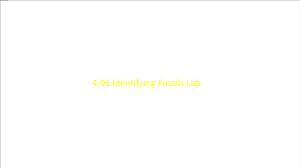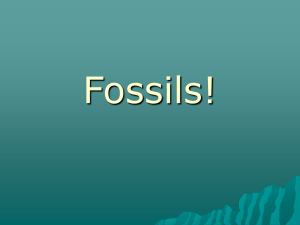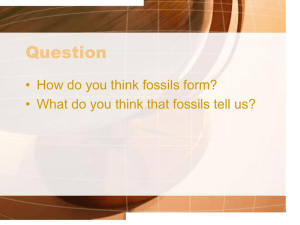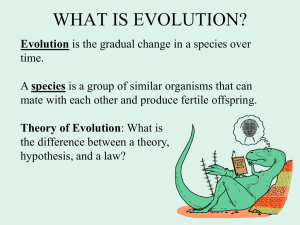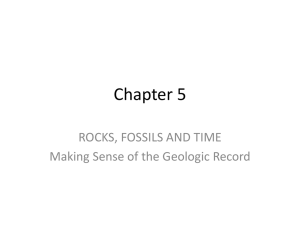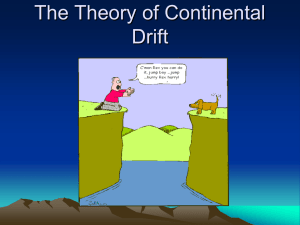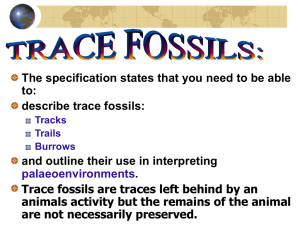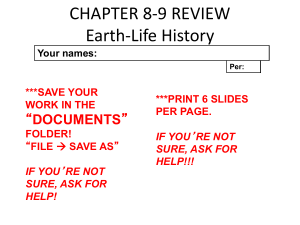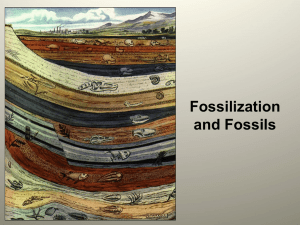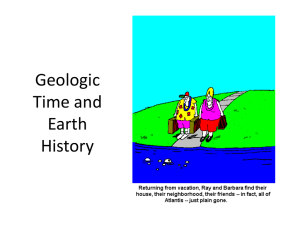Fossils power point
advertisement
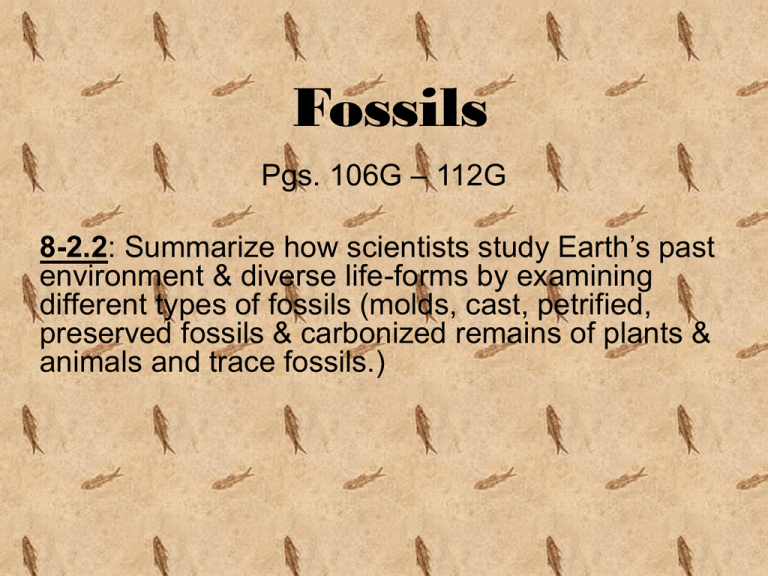
Fossils Pgs. 106G – 112G 8-2.2: Summarize how scientists study Earth’s past environment & diverse life-forms by examining different types of fossils (molds, cast, petrified, preserved fossils & carbonized remains of plants & animals and trace fossils.) Fossils • Fossils are preserved remains or traces of living things. • Most fossils form when living things: 1. die 2. buried by sediments quickly. 3. bones are replaced by minerals. 4. sediments slowly harden into rock and preserve the shapes of the organisms. Can all dead things become a fossil? Types of Fossils • • • • • • Mold Cast Petrified Preserved Carbonized Trace Mold Fossil • A mold is a hollow area in sediment in the shape of an organism or part of the organism. • Forms when sediments bury an organism and the sediments change into rock. – The organism then decays leaving a cavity in the shape of the organism Cast Fossil • Cast is a copy of the shape of an organism. • Forms when a mold is filled with sand or mud that hardens into the shape of the organism. Website • http://www.classzone.com/books/earth_sci ence/terc/content/visualizations/es2901/es 2901page01.cfm?chapter_no=visualizatio n Petrified Fossils • Forms when minerals soak into the buried remains, replacing the remains and changing them into rock. • Petrified fossils are fossils in which minerals replace all or part of the organism. – Petrified means “turning into stone.” Preserved Fossils • Forms when entire organisms or parts of organisms are trapped in ice, tar, or amber and are prevented from decaying. - Iceman found in ice - Amber – insects stuck in the sap - Tar – animals get stuck in tar and die. ICE MAN: preserved in ice Ötzi the Iceman (pronounced [ˈœtsi] (help·info)), and Similaun Man are modern names of a well-preserved natural mummy of a man from about 3300 BC (53 centuries ago).[1] The mummy was found in 1991 in the Schnalstal glacier in the Ötztal Alps, near Hauslabjoch on the border between Austria and Italy. The nickname comes from Ötztal (Ötz valley), the region in which he was discovered. He is Europe's oldest natural human mummy, and has offered an unprecedented view of Chalcolithic (Copper Age) Europeans. AMBER: insects preserved in sap from a tree. TAR: animals fall into tar pits and are buried like saber-toothed cats and mammoths. http://blackhills360.com/bhgalleries/mammogallery.html Carbonized Fossils • Forms when organisms or parts, like leaves, stems, flowers, fish, are pressed between layers or soft mud or clay that hardens squeezing almost all of the decaying organism away leaving the carbon imprint in the rock. • Carbon fossils are a thin coating of carbon on rock. Undetermined Leaf Henefer Formation, Cretaceous, Coalville, Summit Co., Utah Crossopteris utahensis Fern Leaf, Manning Canyon Formation, Pennsylvanian, Lake Mountains, Utah Co., Utah Ginko Leaf Paleocene, Morton Co., North Dakota Macginetea Sycamore leaf, Green River Formation, Eocene, Douglas Pass, Colorado Rhodea Fern Leaf, Manning Canyon Formation, Pennsylvanian, Lake Mountains, Utah Co., Utah Trace Fossils • Form when the mud or sand hardens to stone where a footprint, trail, or burrow of an organism was left behind. • Provides evidence of the activities of ancient organisms. – Size and behavior – Did it walk on two or four legs? – Did it travel alone or with others? – …….. Megalosaurus footprint - A meat eating predator from the Jurassic
